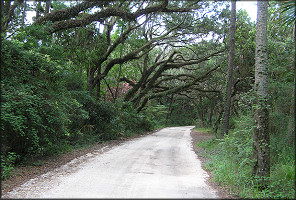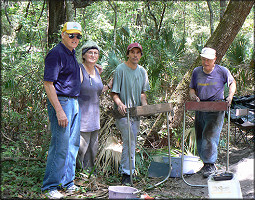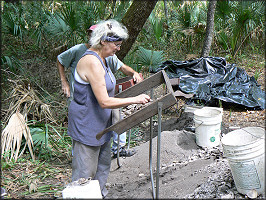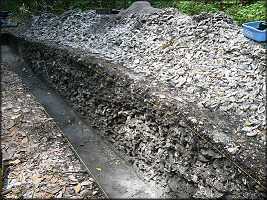| Archaeology Team Really Digs Shells | |
| By Harry G. Lee | |
| [Click on the images for a more detailed version.] | |
|
One recent Sunday afternoon, Vicki
Rolland, a zooarchaelogist working with the State of Florida,
contacted me by email and revealed some interesting discoveries she
and her team had made on Big Talbot Island. Since the principal
stuff of the excavation was the remains of marine and estuarine
shells, she had paid a visit to this website and had hopes club member(s) could
give her a little advice on the taxonomy and life history of the
species she was excavating. |
|
 |
 |
| Big Talbot Island Live Oak Canopy | Harry, Vicki, Keith And Phil |
|
The group was working alongside a
carefully-excavated 16 meter-long, 1 meter-wide trench, the
perfectly horizontal base of which had maximum depth of about 1.5
meters near its middle. This trench was in fact a radial transect of
a subtle donut-shaped mound about forty-five meters in outer
diameter - like the outer quarter of the spoke on a dirt-bike wheel,
and extending beyond the tire an equal distance. This feature is
quite unusual in a landscape that is monotonously flat, and this
topographic disturbance is due to the systematic deposit of the
shells of mollusks by prehistoric peoples. The group had made their
cut through a "Grand Shell Ring" as archaeologists call such a
structure, and had taken out many cubic meters of seashells. They
had gotten almost through the deposit by the time of our visit,
having reached "sterile" dirt (no shell) as Vicki put it, near the
mid-point of the trench. Thus the
excavation phase of the study is nearing completion. |
|
 |
 |
| Vicki Sifts Material From The Trench | The Trench Viewed Outward From Its Nadir |
|
Vicki was particularly interested in the use
of Geukensia and Tagelus as they do not have much of a
"track-record" in the archaeology literature. After due homage to
the gustatory virtues of Quahogs and Eastern Oysters, we addressed
the culinary value those two lesser-known clams. I gave personal
testimony in support of the Ribbed-mussel, and I recounted the
report by late JSC member Dora Chauvin of the traditional Minorcan
dish "longironi" produced in St. Augustine kitchens from Tagelus.
Later, as we walked along the edge of a nearby saltmarsh along
Simpson's Creek, we were able to see fairly dense beds of
Geukensia all-but-completely buried in the dark muck, but
Tagelus, which burrows fairly deeply into the substrate, was not
apparent. Bill and I knew from experience that Oysters and Quahogs
could be had in abundance not far from that point. Terrestrial Species List For
Big Talbot Island Including Those Present At The
Archeological Excavation Site
www.flmnh.ufl.edu (then click the Collections box, then
archaeology or ceramics lab.) |
|